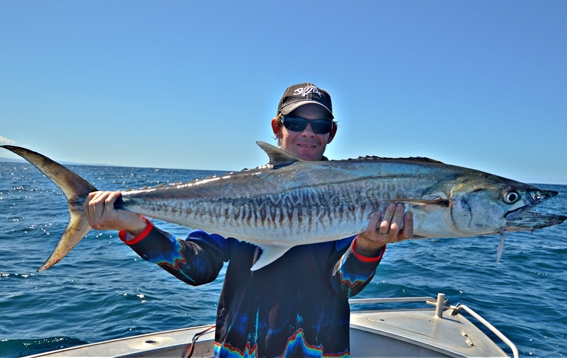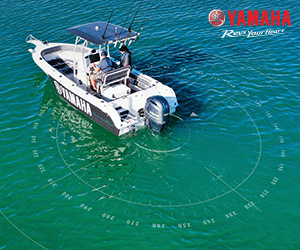SEQ Offshore Pelagic Tips – Cody Hochen 2016
The water temperature is rising and so is my excitement for the upcoming pelagic season. My excitement coincides with thearrival of my 4.8-metre Galeforce over Christmas. My new ride will give me an opportunity to venture further afield to the offshore grounds of south-east Queensland.
I couldn’t have timed it more perfectly for the arrival of: spotted and Spanish mackerel, various tuna species, and many other pelagics soon to arrive from northern pastures around Christmas time. It will be sad to see the Hornet go, but my sadness will be short-lived onceI am loaded with 90 litres of fuel, kept dry, and cruising across South Passage Bar in the ‘galey’.
Earlier this year I was fortunate enough to experience some great lure fishing for pelagics out from Noosa, Mooloolaba and the South Passage Bar. What was amazing was the diversity of species that each trip produced.Those that made it into the boat were Spanish mackerel, kingfish, cobia, spotted mackerel, yellowfin tuna, mac tuna and school mackerel. Many others didn’t and instead were sharked or lost, taking some expensive jewellery.It was a fun few months, with plenty of epic hits, screaming drags and bent rods. Below are two completely different techniques that are useful for catching pelagics that may be surface feeding or feeding deeper in the water column.
Stickbaiting
My favourite and definitely the most exciting way to catch pelagics, is on stickbaits. Seeing a Spanish mackerel or longtail tuna explode over your fast-retrieved stickbait is a sight that will remain etched in your memory. Unfortunately, last year sharks and seizeddrag washers left me without a longtail. However, these unfortunate circumstances were quickly forgotten when a 15kg Spanish mackerel exploded 5 metres out of the water with my stickbait lodged firmly in the corner of its mouth while chasing tuna.This Spaniardwas caught while casting a 120mm Maria Bull Chop to the edge of a school of mac tuna out from Mooloolaba. The Spaniard and a few mateswere feeding on schools of longtom that were around the area. My quickly retrieved skipping stickbait proved perfect for mimicking a fleeing longtom and it was the undoing of my first stickbait caught Spaniard.
Tuna – particularly mac, longtail and yellowfin,are suckers for a stickbait. Around February/March, massive schools of tuna arrive off our coastline, particularly out from Noosa and Mooloolaba. It is common to cross these two bars and immediately stumble across acres of tuna busting the surface. Casting metal lures and softplastics can catch these fish, but I love nothing more than seeing the take by catching them on floating and slow-sinking stickbaits.
To successfully target pelagics on stickbaits it is best to target them whilst they actively feed in the top third of the water column. There are a number of methods for catching pelagics on stickbaits:
- skipping larger 12 – 20cm stickbaits across the surface. Mimicking a larger style of baitfish such as a gar, longtom or flying fish is an effective method for targeting smaller schools of active feeding pelagics;
- a small sinking stickbait twitched just under the surface is very effective for larger schools of pelagics that are feeding on smaller baitfish;
- when large schools of small mac, striped tuna and bonito are around, it pays to
cast larger lures to the edges of the schools. Often larger fish feed on the edges and pick off the smaller tuna.
Spinning metals
Another method that has proved fruitful is targeting pelagics in the bottom half of the water column by vertically spinning large metal slugs. With this technique, it is vital to have a decent sounder to located schools of bait and pelagics deeper in the water column. It is hard to just drive around and find schools of bait and actively-feeding fish, so to increase your chances, search on:edges of reefs and drop-offs, isolated structure, changes in current, and around jetties and pylons. When the current is pushing into this structure, an eddy/pressure point is created in front of the structure. This is the place baitfish use to get out of the current,and pelagics are usually not far behind.
Last year, while trolling around North Reef we located some scattered bait and suspended pelagics on the sounder. Despite trolling over these fishtwice,they were not interested in ourHalco Crazy Deeps. We decided another plan was in order sowith the Minn Kota we anchored directly above the school. While my fishing partner floated a lightly weighted pilchard into the current, I tied on an 80gram Spanyid Raider before dropping it to the bottom and winding it as fast as I could back to the boat.
Within 30 drops, I had a mac tuna, yellowfin tuna and school mackerel all in the boat. Although, not my target species, it was good to find some actively feeding fish. After another 20 drops I received a huge hit, which resulted in a very quick run and a bite off. Undeterred, I knew my target fish were down there, so I tied on another 80 gram raider and dropped it to the bottom. A dozen drops later I watched my lureget engulfed by a silver streak 2 metres under the boat. The fish proceeded to empty the spool of my Shimano Sustain 4000. After 10 minutes of running and circling around the boat, I saw the iridescent blue stripes of a wahoo as he swum just behind the boat. To my astonishment, a much large wahoo was swimming right next to the one I had hooked. Not a minutelaterthe pilchard floater went off so quickly that the spool was half empty before it was out of the rod holder. Unfortunately, I lost my wahoo not long after. The mayhem continued on the nextdrop, as my raiderwas slammed by yet another turbo-charged pelagic. After a 10 minute battle dancing around the boat, and trying to avoid my mate as he fought a wahoo, I tailed my target species: a 15kg Spanish mackerel. Unfortunately, just like my wahoo, he also lost his at the boat. Nevertheless we were soon back in action with a cobia, more tuna and another Spanish mackerel, most caught on large slugs cranked through the bait and suspended fish.
On another trip, we employed the same technique after seeing a nervous school of bait on the surface. Although no pelagics could be seen on the surface, 80 gram raiders were deployed to the bottom and cranked through the tight school of bait.This resulted in two yellowfin tuna, a nice cobia and a school mackerel until the bait dispersed.
After reading an article by Dan Kaggelis in the September issue of Fish and Boat, it sounds as though this method is also very effective when fishing around large jetty pylons in North Queensland. Pressure points form on the current side of a pylon, where baitfish school up and get harassed by all manner of pelagics. Spinning metals around these pressure points and bait schools is a great way to target these pelagics. I am looking forward to trying this method around the Lucinda Jetty during my next visit.
A few tips to get started
When I target pelagics on stickbaits and large metals I use a PE 1.5 – 3 or 2-4 rod matched to 4000 – 6000 spin reels and 30 – 40lb braid. I have found these outfits adequate for smaller pelagics under 20kg, however heavier outfits will be needed if big Spaniards, giant trevally, yellowtail kingfish or wahoo arrive on the scene. Leader depends on what you are chasing. When chasing tuna you can get away with light leader of around 30lb, however when mackerel are around heavy leader is needed to avoid being bitten off. I try to avoid wire since it seems to drastically reduce hits. ‘Sharkings’ and lure losses from bite offs are common when lure fishing for pelagics; so be prepared and bring plenty of spare lures.
It is also vital to have a quality, well-serviced outfit that can withstand 200 metre runs and dogged, drawn out fights.I learnt this lesson the hard way last year when my drag seized during the first run of a longtail tuna. Landing at least 20 mac tuna that day and not servicing the drag in 12 months, proved the undoing of an expensive stickbait and the only shot at a prized longtail that day.Regularly checking and replacing drag washers, conducting 12-monthly major services, and also general maintenance,will have your reel in tip-top shape and ready for the next barrel to explode over your stickbait.
Another tip when chasing pelagics, particularly tuna on lures, is to replace trebles with large Decoy jigging inline single hooks. Singles: (1) allow fish to be released in good condition, (2) result in a solid hook up and, (3) are safer than trebles when a fish is going mental in the boat.
Tides are a huge factor when targeting pelagics. It doesn’t matter whether the tide is running in or out; the key is water movement, and the more movement the better. During this stage of the tide, baitfish have nowhere to hide, therefore forming schools and finding safety in numbers. This is when pelagics switch on and go into feeding mode. During slack tides, bait disperses far and wide, making it hard for pelagics to hunt. This is when it is time to re-rig, tie knots and have lunch.
It must have been said a thousand times before, but birds are the best indicator of bait and therefore pelagics. Paying attention to birds will pay dividends when chasing pelagics. If you spend enough time on the water, you will start to notice bird activity that indicates the presence of pelagics. Terns are the most tell tail bird that will lead you to pelagics in SEQ. Whenever I see scattered terns flying quickly in the same direction I start to get excited. Most of the time, they will lead you towards some sort of pelagic activity. A group of terns floating on the surface oftenindicates the presence of bait, so it pays towatch for their cues for ten or so minutes. I also mark the spot on my sounder to visit a few hours later on another tide.
Now, through to April is my favourite time to be on the water chasing these speedsters. There are so many options available over the coming months.I have outlined two different techniques for targeting pelagics from deep and on top of the water column.Both can be very successful and may produce some very exciting fishing. For the best results, servicereels, stock up on lures, and practice knots so you canexperience the best of the pelagic action this summer.





